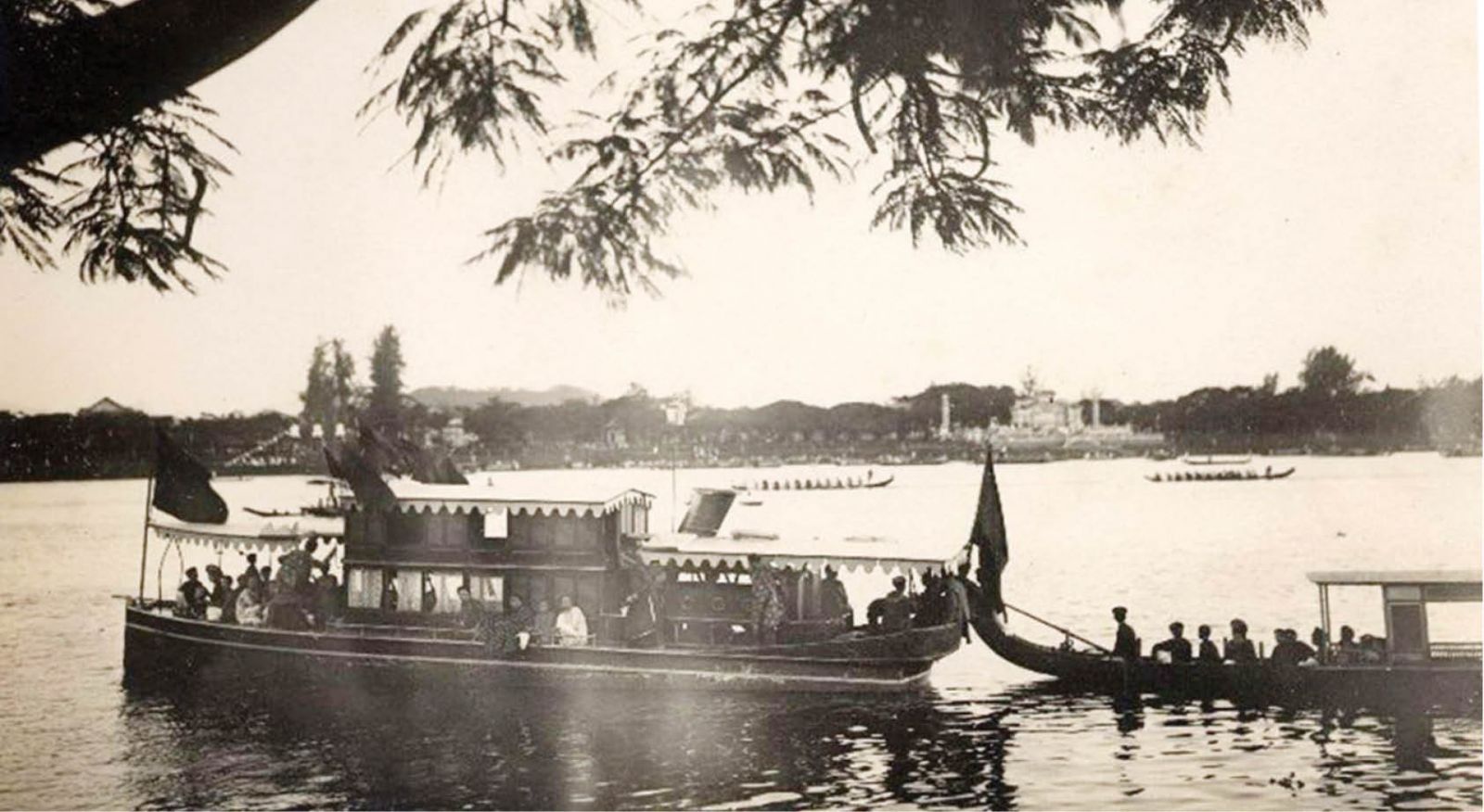From Michel Duc Chaigneau’s memoir
Michel Duc Chaigneau’s mother was a native of Hue. Since his father was emperor Gia Long’s favorite military mandarin, Michel Duc Chaigneau often followed his father into the Imperial Citadel. Deeply attached to Hue, in his memoir, he described the royal cruising ship as a floating palace on the Perfume river.
According to Michel Duc Chaigneau, the emperor owned a cruising ship, which looked like a wooden floating palace with curtained compartments, for his trips or his naps while the weather was hot. The ship was painted and gilded. Between the front and the back compartments was a sail pole with an imperial flag on it.
The whole block looked like a real palace of smaller size and was placed on a big flat ship. The palace was attached to 6-8 smaller boats operated by 50-70 rowers.

The queen mother and the concubines were watching a boat race on the Perfume river on the occasion of emperor Khai Dinh’s 40th birthday in September 1924.
The emperor’s floating palace when in use was accompanied by a small wooden boat operated by four or six rowers. In the center there was a canopy with yellow silk curtains. Its main function was to bring the emperor’s orders to the mandarins.
… to the writing by the Principal of the School of Apprentice Mandarins
Nguyen Dinh Hoe was the principal of the School of Apprentice Mandarins in 1911. During his time there, he carried out many important surveys. In a study announced in 1916, he mentioned Michel Duc Chaigneau and described the cruising ship in detail.
According to Hoe, carving, painting and gilding were properly regulated on mandarins’ ships. Only the emperor and princes owned entirely gilded ships or ones embellished with dragon carving.
The ship for the king to cruise or to take a nap in hot weather was a floating castle, including a main wooden compartment with blinded windows, the living room and his wife’s room. There were also supplementary compartments in the front and at the back. The wooden walls and bamboo blinds were painted and gilded. Between the compartment in the middle and the one at the back was a sail pole with a yellow flag on it.
In order to operate the royal ship, rowers had to practice regularly. Rarely was there any rower who was out of rhythm. A man, as a leader, made sounds with a pair of wooden bars. Now and then he had the rowers sing a song in unison with or without shouting “Hao” at the end of each rhythm. Only on ships for the king and princes was there a leader like that.
Hoe described in detail various ships in the Tu Duc’s era and called them Ngu Chau (meaning “king’s ship.”) Emperor Tu Duc especially liked the ship named Te Thong (meaning “going everywhere”) which was 30 meters long and 4 meters wide. It was entirely closed with the upper floor for the king and the three rooms downstairs for concubines. The ship bow was carved into a dragon head and gilded. At the back were the two dragon bodies slithering out. The boat was drawn by 4-5 boats with 24-32 rowers each.
The ship named Yen Du (meaning “boat for resting”) was dedicated to Empress Dowager Tu Du when she accompanied Tu Duc. This ship was about the size of Te Thong but of one floor only and drawn by 2-4 boats. Its bows were in the shape of phoenixes. The maids working on the ship were all female.
Emperor Tu Duc went hunting on a ship named Tuong Dac (meaning “reasonable.”) It was a small ship operated by women called ban nhan (meaning “female servants.”) They were recruited like warriors, but they just worked as rowers.
The Tuong Long (Flying Dragon) was similar to the Tuong Dac, but she was operated by rowers who ran Long Thuyen. Emperor Tu Duc used this ship for his hunting. It was on this ship that the successive emperor Dong Khanh went to France Residence in 1985 to visit De Coucy.
The emperor owned another one named Binh Dinh, which was simpler than the others used for cruising or hunting around town, and the Le Thuyen (meaning “black ship”) was one of the pulling ships operated by rowers.
In 1876, Bui Vien submitted to emperor Tu Duc his suggestion to found “a navy fleet to patrol all over the country transporting salary money, accompanying merchants, and fighting pirates on the East Sea.”
Emperor Tu Duc agreed immediately. Bui Vien was promoted. Since it was founded, Bui Vien’s fleet of ships had proved its strength in protecting the sea area of the country.
That navy fought the Chinese pirates many times, chasing them to Hai Nam Island in China. Since then, the pirates had not dared to encroach on our sea as before.
Story and photo: Vo Trieu Son